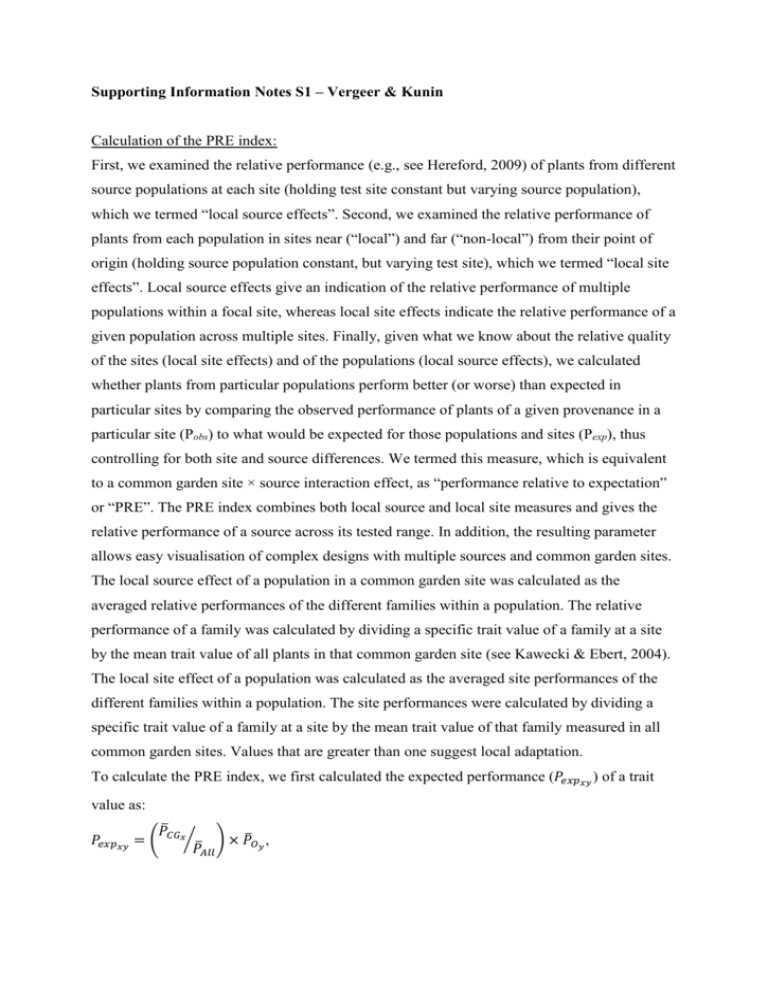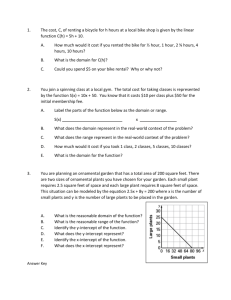nph12060-sup-0004-NotesS1
advertisement

Supporting Information Notes S1 – Vergeer & Kunin Calculation of the PRE index: First, we examined the relative performance (e.g., see Hereford, 2009) of plants from different source populations at each site (holding test site constant but varying source population), which we termed “local source effects”. Second, we examined the relative performance of plants from each population in sites near (“local”) and far (“non-local”) from their point of origin (holding source population constant, but varying test site), which we termed “local site effects”. Local source effects give an indication of the relative performance of multiple populations within a focal site, whereas local site effects indicate the relative performance of a given population across multiple sites. Finally, given what we know about the relative quality of the sites (local site effects) and of the populations (local source effects), we calculated whether plants from particular populations perform better (or worse) than expected in particular sites by comparing the observed performance of plants of a given provenance in a particular site (Pobs) to what would be expected for those populations and sites (Pexp), thus controlling for both site and source differences. We termed this measure, which is equivalent to a common garden site × source interaction effect, as “performance relative to expectation” or “PRE”. The PRE index combines both local source and local site measures and gives the relative performance of a source across its tested range. In addition, the resulting parameter allows easy visualisation of complex designs with multiple sources and common garden sites. The local source effect of a population in a common garden site was calculated as the averaged relative performances of the different families within a population. The relative performance of a family was calculated by dividing a specific trait value of a family at a site by the mean trait value of all plants in that common garden site (see Kawecki & Ebert, 2004). The local site effect of a population was calculated as the averaged site performances of the different families within a population. The site performances were calculated by dividing a specific trait value of a family at a site by the mean trait value of that family measured in all common garden sites. Values that are greater than one suggest local adaptation. To calculate the PRE index, we first calculated the expected performance (𝑃𝑒𝑥𝑝𝑥𝑦 ) of a trait value as: 𝑃̅ 𝑃𝑒𝑥𝑝𝑥𝑦 = ( 𝐶𝐺𝑥⁄̅ ) × 𝑃̅𝑂𝑦 , 𝑃𝐴𝑙𝑙 where 𝑃̅𝐶𝐺𝑥 is the mean performance (𝑃̅) of all plants (all origins) in common garden site x, 𝑃̅𝐴𝑙𝑙 is the mean performance of all plants in all common garden sites and 𝑃̅𝑂𝑦 is the mean performance of all plants from origin y in all common garden sites. A PRE index was then calculated as the relative difference (standardised for expected performance) between the observed and expected performance; 𝑃𝑅𝐸 𝑖𝑛𝑑𝑒𝑥 = (𝑃𝑜𝑏𝑠𝑥𝑦 − 𝑃𝑒𝑥𝑝𝑥𝑦 ) ⁄ 𝑃𝑒𝑥𝑝𝑥𝑦 . Values above zero indicate that plants from particular sources do better than expected in particular sites, based on the relative quality of different sites and sources. References Hereford J. 2009. A Quantitative Survey of Local Adaptation and Fitness Trade-Offs. American Naturalist 173(5): 579-588. Kawecki TJ, Ebert D. 2004. Conceptual issues in local adaptation. Ecology Letters 7(12): 1225-1241.









